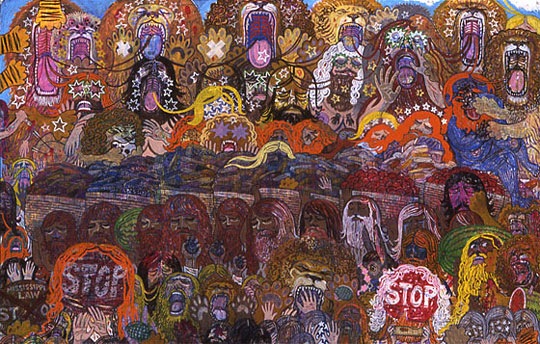Public Domain
November 14, 2003 – January 31, 2004
Opening Reception: Friday, November 14, 2003, 6-9pm
Linda Warren Gallery is pleased to announce Public Domain, a group exhibition featuring works by Amy Bennett, Lance Edwards, Conrad Freiburg, Paula Henderson, Jeremy Long, Mary McCarthy, Alex O’Neal, Pat Roberts, and Dan Witz. Public Domain is an immediate and intuitive experience of the realities of one’s home and surroundings. The show will feature works that explore the relationship between public vs. private spaces, mythologies and properties, while also examining issues of voyeurism, surveillance, and security.
A portion of the proceeds from Public Domain will benefit the James R. Jordan Boys and Girls Club and Family Life Center, a west side Boys and Girls Clubs of Chicago facility dedicated to inspiring and enabling all young people, especially those from disadvantaged circumstances, to realize their full potential as productive, responsible and caring citizens.
The range of media in Public Domain is wide, veering from closely observed oil paintings to loose, gritty monoprints, wooden sculpture, visionary dreamscapes, and deliberate abstraction. Several bodies of work within the show reference the domestic space. Amy Bennett’s meticulously rendered oil paintings of houses and apartments with their roofs or walls removed voyeuristically uncover the everyday goings on in private spaces, depicting scenes that are alternately moving, playful, mundane and fascinating. Similarly, Dan Witz’s paintings of lamps from the lobbies of apartment buildings and of windows seen from the outside evoke a sense of voyeurism or surveillance, while depicting universal suburban and urban icons. Jeremy Long draws upon plein air traditions to create painstakingly detailed oil paintings of urban landscapes, which are specifically observed, but which transcend a particular locale.
The body of popular symbols and mythologies that provide the basis for language features in the work of Alex O’Neal, Conrad Freiburg, and Lance Edwards. Alex O’Neal draws on southern American lore combined with symbols drawn from personal experience to create vast panoramic visionary dreamscapes full of turmoil and an apocalyptic sensibility. Conrad Freiburg’s wooden tree houses draw their inspiration from a quintessential public domain, trees. Freiburg’s houses, built into domestic plants, are evocations of play and nostalgia, also functioning metaphorically as places of refuge. Lance Edwards’ paintings, influenced by graffiti, draw upon combined popular and personal symbols to create environments familiar to the public consciousness, but with a surreal dissonance.
Among the works in Public Domain are a number of pieces that play on variations of the classic modernist grid, suggesting the series of intersections that comprise a map. Among these, Mary McCarthy’s tile paintings function as personal memorials to places where the artist has lived and worked, while opening a space for the viewer to create their own memory associations. Paula Henderson’s paintings on paper simulate the map-like aspects of the grid, using the garden as a metaphor to critique the distribution of public works resources in Chicago. Amy Bennett’s panoramas also feature a variation on the modernist grid in their intersecting domestic walls, and floors.
Pat Roberts’ monoprints are produced from imagery pirated from the internet, a space less material than the physical spaces referenced in the other bodies of work in Public Domain, but just as charged with internal difference, controversy, and contested dominion. In Roberts’ prints, textual elements are added to found photos, creating a new and often satirical take on the mass of images that circulate over the internet. Roberts’ work touches upon the issues of copyright infringement and intellectual property rights, questioning ownership over the images that comprise a vast part of our surrounding world.
